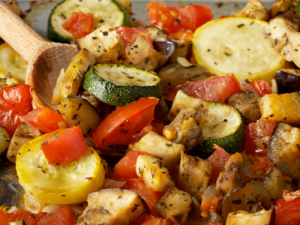Ratatouille to Goose Fat: How French Schools Develop Kids’ Tastes
By Patricia Tennison
www.ParisCafeWriting.com
No doubt about it: taste is developed. The French don’t awaken at age 21 with a penchant for gooey Camembert. They are trained—seriously.
The posted menu in this newsletter is from a public school in the 14th arrondissement in Paris where the families are not rich. However, the food selections make it clear that the French school is serious about teaching students to dine well.
Here’s the full week’s menu:
lundi: spaghetti à la bolognaise; fromage fondu; fruit; gâteau et jus de fruits
Spaghetti on Monday: This is a universal kid-pleaser. It comes with fromage fondu (melted cheese) and fresh fruit. The items listed at the end of each day are the gouter (snacks). For Monday, the snack is gâteau (cake) and fruit juice.
On Tuesday the slope steepens:
mardi: salade de riz Europe; omelette au fromage; ratatouille; Saint Nectaire; fruit; gâteau et lait nature
Lunch—usually the largest meal of the day—is three or four distinct courses, and on Tuesday the children start with a rice salad.
(The French like to note the origin of foods. Here, the school wants to assure parents that the rice is European grown.)
The rice salad is followed by a warm cheese omelet and ratatouille. French kids don’t need a Pixar movie to learn to love slow-cooked eggplant, zucchini, tomatoes, and onions.
The cheese course—served in the French style, before dessert—is a semi-firm, mild, easy-to-like Saint Nectaire. Dessert is fresh fruit.
The snack is cake and lait nature. (Readers: I’m confused here. Warm milk? The posted menu had several typos so maybe this is yogurt from “natural” cow’s milk?)
Wednesday slays me. Look at this:
mercredi: (Repas Froid) rillettes d’oie; rôti de dinde froid; assiette de cruditiés; Coulommiers; compote banane; gâteau et fruit
On Wednesday, the kids start with rillettes d’oie, shreds of goose meat that have been long and lovingly packed in goose fat. This is why, as adults, these students will calmly smear a bit of the same rillettes d’oie on a torn piece of Poilâne bread as they await the main course.
The main course here is rôti de dinde froid, cold roast turkey—easy enough—and a plate of raw vegetables. But then for the cheese course, the kids experience Coulommiers, a runny—if it’s ripe and at room temperature—Brie-like cheese from north central France, an experience most Americans get only if traveling in France.
After the cheese course comes a stewed banana compote for dessert. The snack is cake and fresh fruit.
jeudi: pastèque; sauté de boeuf, condiment choron purée; yaourt nature; gâteau et fruit
On Thursday, the meal starts with watermelon. Easy. Then the beef comes with choron purée (a béarnaise or hollandaise sauce made with a touch of tomato puree). The students learn not just the taste but the names of classic French sauces.
Dessert is yogurt. The snack is cake and fresh fruit.
vendredi: soupe froide de concombre au fromage blanc; pavé de hocki, sauce à l’aneth; jeune carottes; Emmenthal; donut; gâteau et fruit
Lunch on Friday starts with a cold cucumber soup made with fromage blanc, a dairy product a bit like Greek yogurt without the tang. Years ago, I didn’t understand the appeal of fromage blanc, which I found boring. Now, maybe topped with a dollop of fruit, I find it a lovely comfort food. Tastes do change!
To end the week, the students dine on pavé de hocki, sauce à l’aneth (a white fish with dill sauce), plus baby carrots. The cheese course is Emmenthal—and that’s likely a strong, flavorful Emmenthal from Switzerland. For dessert, a donut? Oh, well. It’s Friday.
That was quite a week to develop the taste buds beyond Kraft Lunchables.
However, while French children learn to eat from a sophisticated menu, they might not recognize the food in its original form. The environmental health association of France (ASEF) did a study last year of 910 students ages 8 to 12. They found that the children easily recognized peas, carrots, and watermelon. However, 87% didn’t recognize a whole beet. And only one in three could identify a leek, zucchini, fig, or artichoke.
Of course, this could just mean that the children are not doing the shopping or cooking. The ratatouille simply shows up in front of them at school, at home, or on occasion at a restaurant.
The French typically don’t bring young children out to dine with them at fine restaurants in Paris. However, I did spot a promotion during school vacation this summer at the famous La Coupole brasserie. The restaurant offered a three-course children’s menu for 13.50 euros that included a fruit cocktail, a choice of meat or fish main course, and a dessert.
Besides touting the fresh ingredients, La Coupole encouraged parents to let their children experience “le décor, la cuisine et l’ambience d’une grande brasserie.” The training continues.
To email or to unsubscribe: info@www.pariscafewriting.com
Copyright 2010 Paris Cafe Writing—All Rights Reserved


